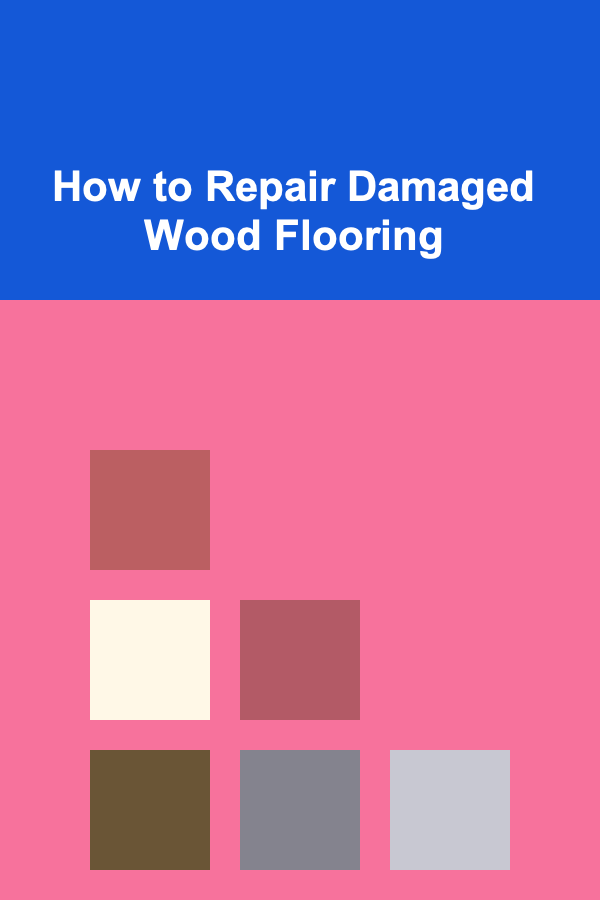
How to Repair Damaged Wood Flooring
ebook include PDF & Audio bundle (Micro Guide)
$12.99$11.99
Limited Time Offer! Order within the next:

Wooden flooring is a timeless choice for both residential and commercial spaces, valued for its aesthetic appeal, durability, and the natural warmth it brings to a room. However, like any other material, wood flooring can be subjected to damage over time due to foot traffic, spills, furniture movement, pet scratches, or even environmental factors such as humidity changes. While damage to wood flooring is inevitable, the good news is that many types of damage can be repaired with the right approach and tools. This comprehensive guide will walk you through the various methods for repairing damaged wood flooring, from minor scratches and dents to more extensive issues like water damage or gaps between planks.
Understanding the Types of Wood Floor Damage
Before diving into repair methods, it's important to understand the different types of damage wood flooring can incur. Each type of damage requires a specific approach, and knowing what you're dealing with will ensure you select the appropriate repair method.
Scratches and Scuffs
Scratches and scuffs are some of the most common forms of damage to wood floors. They occur due to a variety of reasons, such as pet claws, high heels, or dragging heavy furniture across the floor. While they may seem like a minor issue, left unchecked, scratches can degrade the aesthetic appeal of the flooring and, over time, deepen and worsen.
Dents and Gouges
Dents occur when a heavy object impacts the surface of the wood, causing a depression. Gouges are deeper and can tear away pieces of the wood, leaving an open wound in the floor. Both dents and gouges can be unsightly and, if not addressed promptly, can lead to further deterioration of the flooring.
Water Damage
Water damage is one of the most serious issues wood floors can face. Spills that are left untreated, high humidity, or standing water from leaks can cause the wood to warp, buckle, or even rot. Water damage can also cause stains on the surface, which are difficult to remove.
Fading and Discoloration
Exposure to sunlight can cause the natural finish of wood flooring to fade, leaving uneven color patterns across the floor. This is most noticeable in areas that receive direct sunlight for prolonged periods. Similarly, discoloration can occur from certain types of cleaning products or from spills that stain the wood.
Gaps Between Planks
Wood naturally expands and contracts with changes in temperature and humidity, which can cause gaps to form between the planks. These gaps can make the floor look unattractive, and they can also trap dirt and debris, leading to further wear and tear.
Cupping and Crowning
Cupping occurs when the edges of a wood plank become higher than the center, while crowning is the opposite, with the center being higher than the edges. Both conditions are usually caused by moisture issues, such as water exposure or high humidity. Cupping and crowning can make a floor feel uneven and unsafe to walk on.
General Steps for Repairing Damaged Wood Flooring
No matter the type of damage, there are general steps you should follow to ensure a successful repair. These steps provide a framework for any wood floor repair, whether it involves a simple scratch or a more complex issue like water damage.
Step 1: Clean the Area
Before you begin repairing the damaged section of your wood flooring, it's essential to clean the area thoroughly. Dust, dirt, and debris can interfere with the repair process and affect the adhesive, finish, or wood filler. Use a soft cloth or mop to clean the surface. If necessary, use a wood floor cleaner to remove any stains or sticky residue. Make sure the floor is dry before proceeding with repairs.
Step 2: Assess the Damage
Carefully assess the damage to determine its severity. Are you dealing with a surface-level scratch, or is the wood significantly gouged or cracked? For scratches and scuffs, the repair process will be much simpler compared to more extensive damage like water exposure or gaps between planks. Understanding the extent of the damage will help you determine the materials and techniques needed for the repair.
Step 3: Gather the Necessary Tools and Materials
Depending on the type of repair, you will need specific tools and materials. For minor repairs, such as fixing scratches or small dents, you'll only need a wood filler, sanding block, and finish. For more extensive repairs, you might require wood glue, a hammer, wood filler putty, or even replacement planks.
Here's a list of common materials and tools you might need:
- Wood filler or wax sticks (for scratches and small gouges)
- Sandpaper (medium and fine grit)
- Wood glue (for loose planks or gaps)
- Replacement wood planks (for severe damage)
- Putty knife
- Hammer or mallet
- Floor finish or sealant
- Protective gloves and goggles
Repairing Scratches and Scuffs
Scratches and scuffs are relatively easy to repair and can often be fixed without professional help. Here's how to do it:
For Superficial Scratches
- Clean the area: Wipe the scratched area with a clean cloth to remove dust or debris.
- Use a touch-up marker or wax stick: For light scratches, you can use a wood touch-up marker or wax stick that matches the color of your flooring. Gently rub the marker or wax over the scratch, filling it in completely.
- Buff and blend: Once the scratch is filled in, use a soft cloth to buff the area gently, blending the repair into the surrounding wood.
- Apply a finish: If necessary, apply a clear finish to restore the shine and protect the repair.
For Deeper Scratches
- Clean the area: Thoroughly clean the scratch to ensure no dust or dirt is in the way.
- Apply wood filler: Use a wood filler to fill the scratch. Choose a filler that is close in color to your floor. Apply the filler using a putty knife, smoothing it over the scratched area.
- Let it dry: Allow the filler to dry according to the manufacturer's instructions.
- Sand the repair: Once the filler has dried, lightly sand the area with fine-grit sandpaper to ensure the repair is level with the rest of the floor.
- Finish the area: Apply a finish to the repaired area to restore its sheen and protect the wood.
Repairing Dents and Gouges
While dents and gouges are more difficult to repair than scratches, they can still be fixed with the right approach.
For Small Dents
- Moisten the dent: Place a damp cloth over the dent, then use an iron on a low setting to apply heat. The moisture will cause the wood fibers to swell, filling in the dent.
- Let it dry: Allow the wood to cool and dry completely before lightly sanding the area with fine-grit sandpaper.
- Finish the area: Apply a wood finish to restore the look of the floor.
For Deep Gouges
- Clean the gouge: Remove any dirt or debris from the gouged area.
- Fill the gouge: Use a wood filler that matches the color of your floor. Fill the gouge completely with the filler, using a putty knife to smooth it out.
- Let the filler dry: Follow the manufacturer's instructions for drying time.
- Sand the filled gouge: Once the filler is dry, sand the area until it is smooth and level with the surrounding floor.
- Finish the repair: Apply a matching finish or sealant to protect the repair and blend it with the surrounding wood.
Repairing Water Damage
Water damage is one of the most challenging types of damage to repair, and in some cases, it may be beyond repair. However, depending on the severity, it's possible to restore your wood floor.
For Minor Water Damage
- Dry the area: If you catch the water damage early, dry the area immediately with towels or a wet/dry vacuum.
- Sand the affected area: If the wood has warped or developed a discoloration, sand the area lightly with fine-grit sandpaper to level the surface.
- Refinish the floor: After sanding, apply a fresh layer of finish to protect the area from further water damage.
For Severe Water Damage
- Assess the damage: If the wood is severely warped or has developed mold or mildew, the affected planks may need to be replaced.
- Remove the damaged planks: Use a crowbar to carefully remove the planks that have been damaged by water. Be sure to remove any nails or staples that are holding the boards in place.
- Install new planks: Replace the damaged planks with new ones, ensuring they are properly secured.
- Refinish the new planks: Once the new planks are in place, refinish the entire floor to match the existing wood.
Fixing Gaps Between Planks
Gaps between planks can form over time as the wood expands and contracts due to humidity changes. While some gaps are normal, excessive gaps can be unsightly and allow dirt and debris to accumulate.
For Small Gaps
- Clean the gap: Use a vacuum or a brush to clean any dust or debris from the gap.
- Apply wood filler: Choose a wood filler that matches the color of your floor. Apply it into the gap using a putty knife, smoothing it out to make the filler flush with the surrounding wood.
- Sand and finish: Once the filler is dry, lightly sand the area and apply a matching finish to seal the repair.
For Large Gaps
- Fill the gaps with wooden strips: For larger gaps, you may need to fill the space with wooden strips. Cut pieces of wood to fit the gap, then secure them with wood glue or nails.
- Sanding and finishing: After the strips are in place, sand the area to ensure it is flush with the rest of the floor and apply a finish.
Conclusion
Repairing damaged wood flooring may seem like a daunting task, but with the right tools, materials, and techniques, many types of damage can be effectively addressed. Whether you're dealing with scratches, dents, gouges, water damage, or gaps between planks, there are solutions available to restore the beauty and integrity of your wood floor. By carefully assessing the damage, following the appropriate repair method, and taking the necessary steps to maintain your floor, you can ensure that your wood flooring continues to add warmth and elegance to your home for many years to come.
Reading More From Our Other Websites
- [Paragliding Tip 101] Lightweight vs. Heavy-Duty: How to Choose the Perfect Harness for Long-Distance Flights
- [Biking 101] Top 5 Bike Gloves for Every Type of Cyclist
- [Home Pet Care 101] How to Deal with a Picky Eater Pet When Transitioning from Kitten/Puppy Food to Adult Formulations
- [Organization Tip 101] How to Organize Your Budget Around Your Values
- [Organization Tip 101] How to Utilize Leftovers in Your Meal Prep Strategy
- [Organization Tip 101] How to Organize Your Collection of DVDs or Video Games
- [Tiny Home Living Tip 101] How to Build a Tiny Home with a Retractable Roof Deck for Seasonal Outdoor Living
- [Home Cleaning 101] Best Vacuum Cleaners for Pet Hair: Top Picks for Pet Owners
- [Metal Stamping Tip 101] Sustainable Practices in CNC Metal Stamping: Reducing Waste and Energy Use
- [Personal Investment 101] How to Invest in Real Estate with Little Money

How to Create a Farmhouse Look in Your Home on a Budget
Read More
How to Make a Checklist for Engaging Influencers for Product Launch Promotion
Read More
How to Store Shoes Without Cluttering Your Entryway
Read More
How to Transition to a Low-Cost Lifestyle for Financial Freedom
Read More
Innovating the Retail Experience: Trends, Technologies, and Strategies for Today's Manager
Read More
The Art Director's Toolkit: Essential Techniques for Crafting Visual Excellence
Read MoreOther Products

How to Create a Farmhouse Look in Your Home on a Budget
Read More
How to Make a Checklist for Engaging Influencers for Product Launch Promotion
Read More
How to Store Shoes Without Cluttering Your Entryway
Read More
How to Transition to a Low-Cost Lifestyle for Financial Freedom
Read More
Innovating the Retail Experience: Trends, Technologies, and Strategies for Today's Manager
Read More